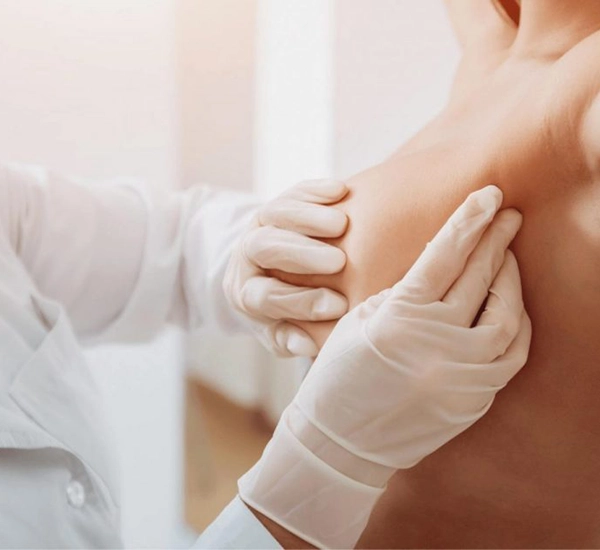
Breast cancer and other pathologies prevention unit

We put within your reach…
Breast Unit for a comprehensive approach to breast pathology.
The Breast Unit is equipped with the most advanced technology in diagnostic tests and we offer a personalised, tailored treatment in each case.
Clinica Tambre is concerned about the integral health of women, and the prevention and early detection of breast cancer is essential to ensure greater survival of patients.
Don’t forget to have annual check-ups.
Frequently asked questions about breast cancer
A breast tumour occurs when cells belonging to the mammary gland grow in an uncontrolled and disorderly manner and create a mass that forms a lump (benign or malignant). Benign tumours are not cancerous. In the case of a malignant tumour (cancer), cancer cells can invade and destroy tissues of other organs.
Ductal carcinoma: begins in the ducts that carry milk from the breast to the nipple (most tumours belong to this type of cancer).
Lobular carcinoma: begins in the lobules or areas responsible for milk production.
But, in addition, many breast tumours are sensitive to estrogen hormones, which cause the tumour to grow. On other occasions (although both circumstances may coincide), certain tumours have cells with too many copies of the HER2 gene, which causes them to multiply rapidly and the response to chemotherapy to be worse.
Breast tumours cannot be prevented, but they can be detected early. Hence the importance of scrupulously following the recommendations for the early diagnosis of cancer. Early detection of breast cancer greatly increases the chances of treatment and cure.
Today, mammography is the diagnostic method par excellence. It is true that in young women, mammographic assessment is sometimes difficult due to the density and quantity of breast tissue. In this case, other techniques, such as nuclear magnetic resonance, can be used. Ultrasound, on the other hand, can diagnose a tumour, but its efficacy is lower than either of the other two techniques.
When breast cancer is suspected, a fine needle puncture of the lesion (FNA) may be performed to obtain and analyse cells from that tissue, which can provide useful information about the existence of cancer. But it will be the biopsy study that will determine whether cancer is present or not.
The most frequent age of onset of a breast tumor is between 50 and 60 years of age, although it is true that they are increasingly being diagnosed in younger women, starting at 30 years of age.
It’s also worth noting that a woman’s chances of developing breast cancer increase if her mother, sister or daughter has had the disease. But only 10% of tumorus are hereditary.
The influence of diet and lifestyle is similar to other tumours: if lifestyle habits are unhealthy, then the risk is higher.
In absolute terms, yes. But it is likely to be due to early detection campaigns, which increase the number of women diagnosed.
Treatment will always depend on the type of tumour and its extension. In most tumours, surgery is indeed the first option, but sometimes chemotherapy (neoadjuvant chemotherapy) is used as a first treatment to reduce the size of the tumor and then perform a less radical surgery.
When a breast tumour is operated on, either only the tumour or the entire breast can be removed (mastectomy). It will depend on the stage, size, age and general condition of the woman, but today, in most cases, the breast can be conserved.
Early detection of the tumour facilitates conservative surgery (removal of the tumour while maintaining as much breast tissue as possible). But it will always be essential to know if there are tumour cells in the axillary nodes (by biopsy) in order to remove them. Today, there is a procedure called sentinel node biopsy in which only one lymph node is removed to find out if the cancer has spread to the nodes in the armpit. If it has tumour cells, the axillary nodes are removed; if not, it will not be necessary, avoiding axillary surgery and its side effects.
When mastectomy is the most appropriate option, breast reconstruction should be performed, either after removal of the breast or subsequently.
The characteristics of each tumour determine the type of treatment after surgery.
Hair loss, lack of appetite, nausea, vomiting, diarrhoea, constipation or alterations in the tissue inside the mouth are some of the most common side effects. Most of the effects gradually disappear after treatment is completed. In addition, patients may have permanent complications, such as premature menopause or infertility.
It will depend on the type of intervention. Complications include seromas (fluid accumulation), infections or abscesses. But the most important sequela is lymphedema, which is a swelling of the arm due to the removal of the axillary lymph nodes, for which there is no effective treatment. The application of the sentinel lymph node technique will make this type of sequela less and less frequent.
Recommendations for the early diagnosis of cancer:
Annual gynaecological check-ups (breast screening)
Mammograms:
Patients with risk factors (family history, etc.) should have their first mammogram after the age of 35, on an annual basis.
While in patients without risk factors, the first mammogram should be performed at the age of 40.
Between the ages of 40 and 50, a mammogram is recommended every two years.
From the age of 50, on an annual basis.
